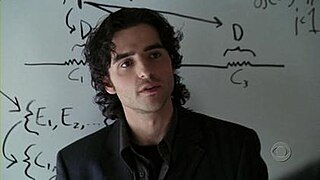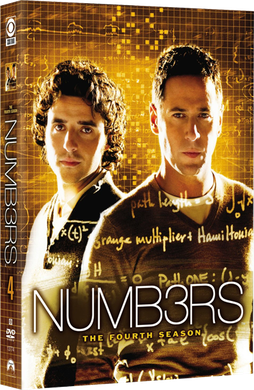
Numbers is an American crime drama television series that was broadcast on CBS from January 23, 2005, to March 12, 2010, for six seasons and 118 episodes. The series was created by Nicolas Falacci and Cheryl Heuton, and follows FBI Special Agent Don Eppes and his brother Charlie Eppes, a college mathematics professor and prodigy, who helps Don solve crimes for the FBI. Brothers Ridley and Tony Scott produced Numbers; its production companies are the Scott brothers' Scott Free Productions and CBS Television Studios.

Charles Edward Eppes, Ph.D., is a fictional character and one of the protagonists of the CBS crime drama Numb3rs. He is portrayed by David Krumholtz.

Larry Fleinhardt, Ph.D., is a fictional character in the CBS crime drama Numb3rs, played by Peter MacNicol. He is the best friend and colleague of Charlie Eppes.

The second season of Numbers, an American television series, premiered on September 23, 2005, and its season finale was on May 19, 2006. Season two sees several changes to Don's FBI team: Terry Lake is reassigned to Washington DC and two new members join Don and David Sinclair: Megan Reeves and Colby Granger. Charlie is challenged on one of his long-standing pieces of mathematical work and also starts work on a new theory, Cognitive Emergence Theory. Larry sells his home and lives a nomadic lifestyle, while he becomes romantically involved with Megan. Amita receives an offer for an assistant professor position at Harvard University but is plagued by doubt as her relationship with Charlie is challenged and her career is in upheaval. Alan begins working and dating again, though he struggles with the loss of his wife.

Amita Ramanujan, Ph.D., is a fictional character from the CBS crime drama Numb3rs, played by Navi Rawat. Over the course of the series, she has become a professor at CalSci and has since become romantically involved with her former thesis advisor, Dr. Charlie Eppes. She was first introduced in "Pilot". She also works as an FBI consultant with Charlie and Larry.

The third season of Numbers, an American television series, premiered on September 22, 2006 with the episode "Spree" and had its season finale "The Janus List" on May 18, 2007. Charlie and Amita intensify their relationship, as do Larry and Megan. Amita has troubles adjusting in her new role as a CalSci professor, and Larry announces his leave of absence—he will be on the space station for six months, which greatly distresses Charlie. Dr. Mildred Finch, the newly appointed Chair of the CalSci Physics, Mathematics, and Astronomy Division, initially troubles Charlie and his colleagues, as Alan dates her. Don dates Agent Liz Warner, questions his ethics and self-worth, and receives counseling. Charlie sees Don's therapist and the two understand one another more. Alan engages in some FBI consulting with his knowledge of engineering, and Larry returns from the space station, although disillusioned. The finale wraps up with a revelation that shakes the whole team.

The fourth season of Numbers, an American television series, first aired on September 28, 2007 and ended on May 16, 2008. Because of the Writers Guild of America strike, only 12 episodes were initially produced for this season. Following the end of the strike, six more were announced.

The fifth season of Numbers, an American television series, first aired on October 3, 2008 and ended on May 15, 2009. The season premiere was moved back one week as a result of the presidential debates.

The sixth and final season of Numbers, an American television series, first aired on September 25, 2009 and ended on March 12, 2010, on CBS. This season featured only 16 episodes.
"Harvest" is the 14th episode of the second season of the American television show Numbers. Inspired by a Christian Science Monitor article about organ tourists, people who travel to a different country to give their organs for money, and an algorithm developed in the United States, the episode features Federal Bureau of Investigation (FBI) agents and mathematicians attempting to locate a missing organ tourist before she is killed.
"Provenance" is the third episode of the third season of the American television show Numbers. Inspired by real-life instances, the episode features a Federal Bureau of Investigation (FBI) investigation into a stolen painting which may have a tainted provenance. Gena Rowlands, who works as an advocate for Holocaust survivors, portrayed a Holocaust survivor who claimed that the painting was originally her family's painting. Within the series, the episode also depicts the Eppes family as Jewish.
"Spree" is the first episode of the third season of the American television show Numbers The episode features Federal Bureau of Investigation (FBI) agents pursuing a couple of spree killers. Series writer Ken Sanzel drew inspiration for the episode from pursuit curves. "Spree" also launches a more general trend toward the serialization of the series.
"Killer Chat" is the 11th episode of the third season of the American television show Numbers. In the episode, Federal Bureau of Investigation (FBI) agents investigate the murders of several child molesters while a pair of mathematicians prepare to say goodbye to a friend. Stories about child molesters and his own experiences as a parent inspired series writer Don McGill to write the episode.
"The Art of Reckoning" is the 21st episode of the third season of the American television show Numbers. In the episode, Federal Bureau of Investigation (FBI) agents investigate the confessions of a mob hit man before his execution. Written by Julie Hébert, the episode also highlighted the return of series regular Peter MacNicol as his character, Dr. Larry Fleinhardt, returned from space.
"When Worlds Collide" is the 18th episode and the season finale of the fourth season of the American television show Numbers. In the episode, two brothers, one a Federal Bureau of Investigation (FBI) Special Agent and the other a mathematician, disagree with each other on the issue of academic freedom after one of the mathematician's friends is arrested on terrorism charges. Series creators Cheryl Heuton and Nicolas Falacci, who wrote the episode, first mentioned the idea for the brothers' conflict during a season two commentary. When Heuton and Falacci wrote the episode for season four, their episode launched a story arc that was later resolved during season five.
"Disturbed" is the 21st episode of the fifth season of the American television show Numbers. In the episode written by series creators/executive producers Cheryl Heuton and Nicolas Falacci, skeptical Federal Bureau of Investigation (FBI) agents track an undetected serial killer while their math consultant copes with his brother's recent injury. After FBI Special Agent Don Eppes's injury, FBI Special Agent David Sinclair, who was the newest member of the team at the beginning of the series, served as team leader. Falacci and Heuton also included Easter eggs from the "Pilot" and from some of the previous 99 episodes.
"Angels and Devils" is the 23rd episode and the fifth season finale of the American television show Numbers. In the episode, Federal Bureau of Investigation (FBI) agents search for a mathematician who has been kidnapped by a cult leader. The episode ended with a character's priorities changed and a marriage proposal left unanswered. James Callis guest-starred as the cult leader, Mason Dureya.
"Cause and Effect" is the 16th episode and the season finale of the sixth season and series finale of the American television series Numbers. In the episode, Federal Bureau of Investigation (FBI) agents and mathematicians attempt to find one agent's gun before it is used in a violent crime. When series creators/executive producers Cheryl Heuton and Nicolas Falacci learned that the number of episodes airing during the season was reduced, they felt that they needed to finish storylines in case the series was cancelled. To do so, they wrote an open-ended story to serve as either a season finale or a series finale.









